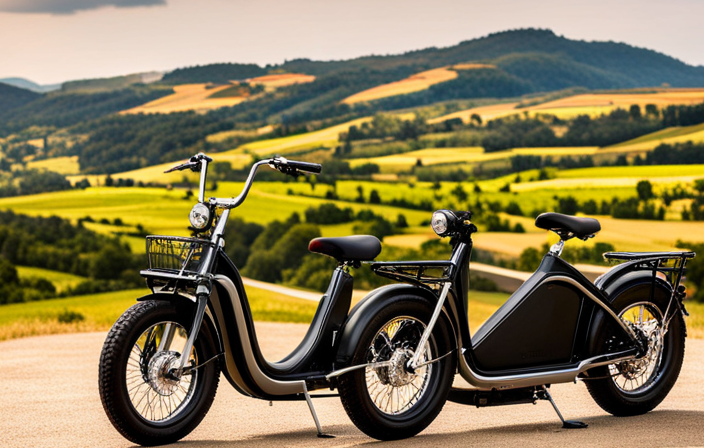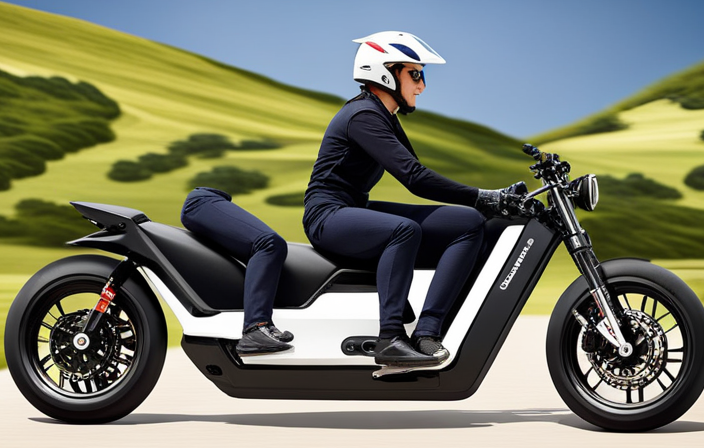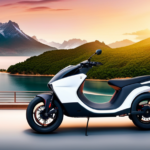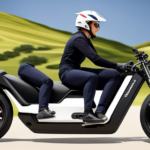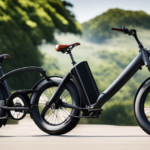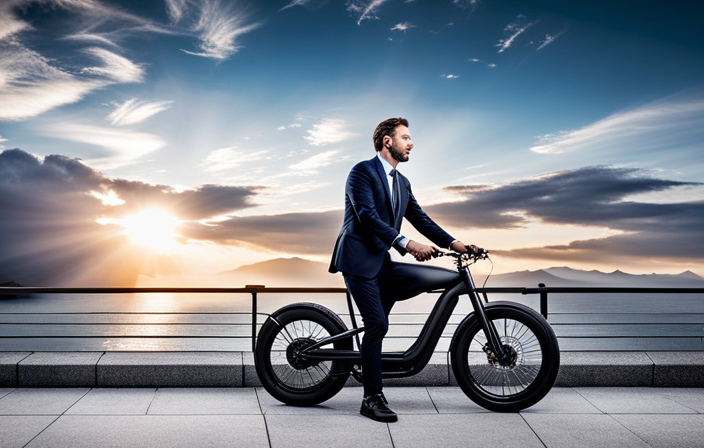Like a modern-day explorer, I mount my electric bike and set off on a journey of discovery. With each pedal stroke, I feel the exhilaration of freedom and the anticipation of how far I can go.
In this article, we will delve into the world of electric bike range, exploring the factors that affect it, tips to extend it, and real-life examples of just how far these bikes can take us.
So buckle up and join me on this electrifying adventure.
Key Takeaways
- Battery capacity directly affects travel distance
- Different types of electric bikes have varying ranges
- Factors such as terrain, weight, and weather conditions impact range
- Tips such as proper tire inflation and pedaling along with the motor can help extend range
Understanding Electric Bike Range
You can understand electric bike range by considering factors such as battery capacity and terrain.
Battery capacity is an essential factor that directly affects how far you can travel on your electric bike. Higher capacity batteries generally provide longer range, allowing you to go further on a single charge. However, it’s important to note that terrain plays a significant role as well.
Riding on flat, smooth surfaces will enable you to cover more distance compared to hilly or off-road terrains. Additionally, other factors affecting range include your weight, the weight of any cargo you’re carrying, and even weather conditions.
To maximize your electric bike’s range, you can try pedaling more and using lower power assist levels. In the subsequent section about factors affecting electric bike range, we will delve deeper into these considerations.
Factors Affecting Electric Bike Range
When considering the range of an electric bike, it is important to take into account several factors.
The battery capacity and type play a significant role in determining how far you can travel on a single charge.
Additionally, the terrain and elevation changes can greatly impact the range of the bike, as uphill climbs require more power.
Lastly, the rider’s weight and riding style also affect the range, as heavier riders may require more energy and aggressive riding can drain the battery quicker.
By understanding these key points, you can better assess the range of your electric bike and plan your rides accordingly.
Battery Capacity and Type
To maximize your travel distance, choose an electric bike with a high-capacity battery and the appropriate type for your riding needs. The battery capacity determines how much energy the bike can store, which directly impacts the battery life and how far you can travel on a single charge. Additionally, the type of battery you choose can also affect the range of your electric bike. Lithium-ion batteries are the most common type used in electric bikes due to their high energy density and longer lifespan. They are lightweight and provide a good balance between power and range. On the other hand, lead-acid batteries are cheaper but heavier and have a shorter lifespan. To help you understand the differences better, refer to the table below:
| Battery Type | Energy Density | Lifespan |
|---|---|---|
| Lithium-ion | High | Long |
| Lead-acid | Low | Short |
Considering the battery capacity and type is crucial when selecting an electric bike to ensure you can cover the desired distance. Now, let’s move on to the next section where we will discuss how terrain and elevation changes affect the range of your electric bike.
Terrain and Elevation Changes
Terrain and elevation changes greatly impact the range of an electric bike. When riding on flat terrain, the electric bike can easily maintain a consistent speed and cover more distance. However, when faced with uphill climbs or steep terrain, the electric bike’s battery will be put under more strain, resulting in a decrease in range. The motor will have to work harder to overcome these obstacles, leading to a decrease in speed as well.
Additionally, riding downhill can also affect the range of the electric bike, as the motor may not need to provide as much power, resulting in a longer range. Transitioning into the subsequent section about rider weight and riding style, it is important to consider these factors in order to maximize the range of an electric bike.
Rider Weight and Riding Style
Rider weight and riding style greatly influence the performance of an e-bike. The weight of the rider can impact the speed and range of the electric bike. Heavier riders may experience a decrease in both speed and distance that the bike can travel on a single charge. This is because the motor has to work harder to propel the bike forward with the added weight.
Additionally, riding style plays a role in determining how far you can travel with an electric bike. Aggressive riding styles that involve constant acceleration and high speeds can drain the battery faster, resulting in a shorter range. On the other hand, a more conservative riding style that focuses on maintaining a steady pace and using pedal-assist wisely can extend the range of the e-bike.
Therefore, it is important to consider both rider weight impact and choosing the right riding style when using an electric bike.
Transitioning to the next section, different types of electric bikes and their range can also affect the distance you can travel.
Different Types of Electric Bikes and Their Range
There’s a wide variety of electric bikes available, each with its own range. When comparing the electric bike range, it’s important to consider factors such as battery capacity, motor power, and terrain.
Here are four types of electric bikes and their average range:
-
City Electric Bikes: Designed for urban commuting, these bikes have a range of around 30-60 miles. They are equipped with smaller batteries and motors, making them lighter and more agile in crowded areas.
-
Hybrid Electric Bikes: Ideal for both city and off-road riding, these bikes have a range of approximately 40-80 miles. With larger batteries and motors, they offer more power and versatility.
-
Mountain Electric Bikes: Built for rugged terrains, these bikes have an average range of 25-50 miles. They feature robust frames, wide tires, and powerful motors to tackle steep inclines and rough trails.
-
Long-Range Electric Bikes: Designed for extended adventures, these bikes have a range of 70-100 miles. They come with larger batteries and motors, allowing riders to explore farther distances.
Using an electric bike offers numerous benefits, including reducing carbon emissions, saving money on fuel, and promoting a healthier lifestyle. To extend your electric bike’s range, stay tuned for tips in the next section.
Tips to Extend Your Electric Bike’s Range
To get the most out of your electric bike and extend its range, there are several tips and tricks you can follow. By optimizing its performance, you can go further and enjoy longer rides. One way to extend your electric bike’s range is by keeping your tires properly inflated. This reduces rolling resistance and increases efficiency. Another tip is to pedal along with the motor, as this helps to conserve battery power. Additionally, you can adjust your bike’s power settings to a lower level when riding on flat terrain or when you don’t need the extra assistance. By following these tips and making small adjustments, you can significantly increase the distance you can travel on your electric bike. Now, let’s delve into real-life examples and explore how far you can actually go.
Real-Life Examples: How Far Can You Go?
When it comes to commuting in urban areas, an electric bike can be a game-changer in terms of convenience and cost savings.
With the ability to travel longer distances without getting tired, I can easily navigate through traffic and arrive at my destination in no time.
Exploring off-road trails is another exciting adventure that an electric bike allows me to embark on. With its powerful motor and sturdy build, I can conquer rough terrains and enjoy the beauty of nature without breaking a sweat.
Lastly, for those seeking long-distance touring adventures, an electric bike is a reliable companion. With its extended range and efficient battery, I can cover more ground and explore new destinations with ease.
Commuting in Urban Areas
If you live in an urban area, you can easily commute with an electric bike. Urban commuting presents its own challenges, with traffic congestion, limited parking, and high transportation costs. However, electric bikes offer a solution to these problems.
With their ability to navigate through traffic, electric bikes can help you reach your destination faster and without the stress of being stuck in gridlock. They are also much more cost-effective than traditional forms of transportation, as they require minimal maintenance and no fuel expenses.
Additionally, electric bikes are environmentally friendly, producing zero emissions and reducing air pollution in crowded cities. With all these benefits, electric bikes are the perfect choice for commuting in urban areas.
And when you’re done with your daily commute, you can even take your electric bike off-road and explore thrilling trails.
Exploring Off-Road Trails
For an exhilarating adventure, head off the beaten path and explore off-road trails.
Electric bikes are not just for commuting in urban areas; they are also perfect for exploring scenic trails. With the right bike and proper planning, you can have an amazing off-road experience while maximizing your battery life.
When choosing an electric bike for off-road trails, look for features like a robust frame, wide tires with good traction, and a powerful motor. Additionally, make sure to plan your route carefully, considering the terrain and the distance you want to cover.
By adjusting your riding style, utilizing pedal assist wisely, and conserving battery power when necessary, you can explore trails for longer distances.
So, get ready to hit the trails and embark on unforgettable long-distance touring adventures.
Long-Distance Touring Adventures
When it comes to electric bikes, the possibilities for adventure are endless. After exploring off-road trails and experiencing the thrill of nature, I found myself craving even more. That’s when I discovered the world of long-distance touring adventures. Long distance bikepacking allows you to travel for extended periods, exploring scenic routes and immersing yourself in the beauty of the great outdoors. With an electric bike, you can cover more ground and go further than ever before. Whether you want to embark on a cross-country expedition or simply enjoy a weekend getaway, long-distance touring adventures offer a unique and exhilarating experience. Strap on your gear, plan your route, and get ready to embark on an unforgettable journey. And as you venture into the next section about charging your electric bike on the go, you’ll learn how to keep your adventure powered up.
Charging Your Electric Bike on the Go
To charge your electric bike on the go, you can easily find charging stations along your route. Thanks to the growing popularity of electric bikes, charging infrastructure is becoming more widespread, making it convenient to charge your bike wherever you are.
Many cities and towns now have dedicated charging stations specifically designed for electric bikes, allowing you to top up your battery while taking a break. Additionally, there are portable charging solutions available that you can carry with you, such as solar panels or power banks, which can provide an extra boost when needed.
These options give you peace of mind and ensure that you can always find a way to charge your bike while on long-distance touring adventures. With the accessibility of charging stations and portable solutions, you can overcome range anxiety and enjoy worry-free travel on your electric bike.
Overcoming Range Anxiety
When it comes to overcoming range anxiety with my electric bike, there are a few key points I always keep in mind.
First and foremost, I make sure to plan my routes carefully, taking into consideration the distance I can comfortably travel on a single charge.
Additionally, knowing my bike’s limits is crucial, as it helps me gauge when I might need to recharge or find a charging station.
Lastly, building confidence in my bike’s range comes with experience and understanding its capabilities, allowing me to confidently explore new routes without the worry of running out of power.
Planning Your Routes
If you’re planning your routes, make sure to consider any elevation changes along the way. These changes can have a significant impact on the range of your electric bike. To help you plan your routes effectively and make the most of your battery’s capacity, here are three key things to keep in mind:
-
Opt for flatter routes: Climbing steep hills can drain your battery quickly, so try to choose routes that have less elevation change. This will help you conserve energy and extend your bike’s range.
-
Take advantage of regenerative braking: Many electric bikes have regenerative braking systems that can recharge the battery when you brake or go downhill. By utilizing this feature, you can recover some energy and increase your overall range.
-
Plan for charging stops: If you’re going on a longer ride, it’s important to plan for charging stops along the way. Look for places where you can plug in your bike and take a break while it charges, such as cafes, parks, or public charging stations.
Considering these factors will help you make the most of your electric bike’s range and ensure that you reach your destination without any range anxiety.
Now, let’s delve into the next section about knowing your bike’s limits.
Knowing Your Bike’s Limits
Understanding the limitations of your bike is crucial for a successful ride. When it comes to electric bikes, knowing the range estimation and optimizing battery usage are key factors. To help you visualize this, let’s take a look at a table comparing different electric bike models and their average ranges:
| Electric Bike Model | Average Range |
|---|---|
| Model A | 30 miles |
| Model B | 40 miles |
| Model C | 50 miles |
By understanding your bike’s range and battery capacity, you can plan your routes accordingly and avoid running out of power in the middle of a ride. It’s important to optimize battery usage by utilizing features such as pedal-assist modes and adjusting your speed. Building confidence in your bike’s range will allow you to explore further and enjoy longer rides without worrying about running out of battery.
Building Confidence in Your Bike’s Range
To build confidence in your bike’s range, it’s essential to have a clear understanding of its limitations and optimize battery usage. Here are three ways to boost range confidence and maximize battery efficiency:
-
Plan your route: Before embarking on a long journey, research the terrain, inclines, and potential charging points along the way. This will help you gauge how far your bike can go and plan accordingly.
-
Use energy-saving features: Many electric bikes come with energy-saving modes or power assist levels that can help extend battery life. Experiment with different settings to find the balance between performance and range.
-
Maintain your bike: Regular maintenance, such as keeping the tires properly inflated and ensuring the drivetrain is clean and lubricated, can significantly impact your bike’s efficiency and range.
By following these tips, you can feel more confident in your bike’s range and maximize its battery efficiency.
Looking ahead to the future of electric bike range, advancements in battery technology and charging infrastructure will continue to improve the overall experience of riding an electric bike.
The Future of Electric Bike Range
The future of electric bike range is looking bright with advancements in battery technology, the integration of solar charging, and innovations in energy efficiency.
Battery technology is constantly improving, allowing for longer-lasting and more powerful batteries.
The integration of solar charging means that electric bikes can harness the power of the sun to extend their range.
Additionally, innovations in energy efficiency are making electric bikes more efficient than ever before, allowing riders to go even further on a single charge.
Advancements in Battery Technology
You can go even farther with advancements in battery technology for your electric bike.
The integration of renewable energy sources, such as solar power, has greatly impacted the battery technology in the electric vehicle industry. This integration has allowed for the development of more efficient and powerful batteries, which in turn extends the range of electric bikes.
These advancements have led to the creation of lithium-ion batteries, which are lighter, smaller, and have a higher energy density compared to traditional lead-acid batteries. With these improved batteries, you can now travel longer distances on your electric bike without worrying about running out of power.
The integration of solar charging further enhances the battery technology by providing a sustainable way to recharge your electric bike while on the go. This allows for even greater range and the freedom to explore new destinations.
Integration of Solar Charging
By integrating solar charging into your electric bike, you can harness the power of the sun to extend your range and explore new destinations. Solar panel efficiency has greatly improved in recent years, making it more practical to incorporate solar charging into electric bikes. These advancements allow for smaller, more lightweight solar panels that can be easily mounted onto the bike without adding excess weight. Additionally, portable solar charging options are available, allowing you to charge your bike on the go, even when there are no electrical outlets nearby. These portable chargers can be folded up and carried with you, providing a convenient and sustainable way to keep your electric bike powered up. With the integration of solar charging, you can go further and experience the freedom of exploring without limitations. In the subsequent section about innovations in energy efficiency, we’ll explore other ways to maximize your electric bike’s range and performance.
Innovations in Energy Efficiency
As we explored the integration of solar charging in the previous subtopic, let’s now delve into the innovations in energy efficiency that contribute to the overall range of electric bikes. These advancements play a crucial role in determining how far we can travel with an electric bike.
-
Lightweight materials: The use of lightweight components, such as carbon fiber frames, reduces the overall weight of the bike, making it more energy-efficient and increasing its range.
-
Regenerative braking: The advantages of regenerative braking cannot be overstated. It allows the bike to convert the kinetic energy generated while braking into electrical energy, which is then stored in the battery for later use.
-
Weather conditions: It is important to consider the impact of weather conditions on the range of an electric bike. Factors like headwinds, rain, or extreme temperatures can affect battery performance and reduce the overall range.
-
Aerodynamics: Innovations in aerodynamic design, such as streamlined frames and components, minimize wind resistance, allowing the bike to travel further on a single charge.
With these energy-efficient features, we can now move on to comparing electric bike ranges.
Electric Bike Range Comparison
When comparing electric bikes to electric scooters, electric bikes have a clear advantage in terms of range. Electric bikes can travel much farther on a single charge compared to electric scooters, allowing riders to go on longer rides without worrying about running out of battery.
Similarly, when comparing electric bikes to traditional bicycles, electric bikes offer the benefit of assisted pedaling, allowing riders to go further and faster with less effort.
Finally, when comparing electric bikes to electric cars, electric bikes have a much smaller range but also have the advantage of being much more compact and maneuverable, making them a great option for urban commuting.
Electric Bikes vs. Electric Scooters
With an electric bike, you can travel much farther compared to an electric scooter. Electric bikes have a significantly longer range than electric scooters, allowing you to go on longer journeys without worrying about running out of battery.
When comparing electric bikes to public transportation, electric bikes offer the advantage of being able to travel directly to your destination without the need for transfers or waiting times. They also provide a faster commute compared to walking, especially for longer distances.
Electric bikes are equipped with a motor that assists you while pedaling, making it easier to cover longer distances with less effort. This makes them a practical and efficient mode of transportation for both commuting and recreational purposes.
Moving on to the next section about electric bikes vs. traditional bicycles, it is important to consider the differences between the two options.
Electric Bikes vs. Traditional Bicycles
Consider the benefits and differences between electric bikes and traditional bicycles. Here are four key points to help you understand the advantages of electric bikes over traditional bicycles:
-
Longer Range: With electric bikes, you can travel much farther compared to traditional bicycles. This extended range makes electric bikes a great alternative to public transportation, especially for short to medium distance commutes.
-
Increased Speed: Electric bikes allow you to reach higher speeds effortlessly, making them faster than traditional bicycles. While they may not match the speed of motorcycles, electric bikes still provide a significant boost in speed, allowing you to arrive at your destination quicker.
-
Reduced Effort: Electric bikes provide assistance when pedaling, reducing the effort required to ride. This makes them a more comfortable and accessible option, especially for individuals who may not have the physical fitness or stamina for traditional bicycles.
-
Eco-Friendly Option: Electric bikes are a greener alternative to motorcycles, as they produce zero emissions. They also have a lower carbon footprint compared to traditional bicycles, as they require less physical exertion and can encourage more people to choose biking as a mode of transportation.
Looking ahead to the next section, let’s explore the benefits of electric bikes compared to electric cars.
Electric Bikes vs. Electric Cars
Electric bikes provide a convenient and eco-friendly alternative to traditional bicycles. They are a viable option for short trips or commuting within a city. However, they may not be suitable for longer journeys.
Electric cars, on the other hand, are a more practical option for longer distances and commuting. They offer more range and can travel much farther without the need for recharging. Electric cars also provide a safer and more comfortable ride, with features like air conditioning, enclosed cabins, and better stability.
In comparison to public transportation, electric bikes are a more cost-effective and efficient choice. They offer a similar level of convenience and comfort as motorcycles. Embracing the freedom of electric bike travel means enjoying the benefits of both modes of transportation without sacrificing range or comfort.
Conclusion: Embrace the Freedom of Electric Bike Travel
Embrace the freedom of electric bike travel and experience the joy of exploring new places. Electric bikes offer a unique and eco-friendly mode of transportation that allows you to travel further while minimizing your carbon footprint.
The benefits of electric bike travel are plentiful. First and foremost, it is an environmentally conscious choice that reduces air pollution and greenhouse gas emissions. Additionally, electric bikes provide an excellent opportunity for exercise, as you can still pedal and get a workout while enjoying the assistance of the electric motor.
Moreover, electric bikes are cost-effective, as they require less maintenance and have lower operating costs compared to cars. With their ability to cover long distances and navigate through traffic easily, electric bikes truly offer a new level of freedom and flexibility in travel.
So why not embrace this sustainable mode of transportation and discover the world around you in a whole new way?
Frequently Asked Questions
Are all electric bikes created equal in terms of range?
Not all electric bikes are created equal in terms of range. The range of an electric bike is influenced by factors such as battery capacity, terrain, rider weight, and speed. These factors can affect how far you can travel on an electric bike.
Can I use my electric bike for long-distance commuting?
On average, electric bike battery life allows for up to 50 miles of travel. Long-distance commuting with an electric bike offers numerous benefits, including reduced carbon emissions, cost savings, and improved physical fitness.
How does the weight of the rider and cargo affect the electric bike’s range?
The weight of the rider and cargo can significantly affect the electric bike’s range. Heavier loads require more power to propel the bike, reducing the range. Additionally, riding uphill or with aggressive acceleration can also decrease the range.
Are there any safety precautions I should take when riding an electric bike on long journeys?
When riding an electric bike on long journeys, it is important to ensure proper maintenance, such as checking the battery charge and tire pressure regularly. Additionally, essential safety gear like a helmet, reflective clothing, and lights should be worn to enhance visibility and protect oneself.
What are the differences in range between different battery types used in electric bikes?
"A smaller battery capacity can limit the range of an electric bike, while a larger capacity can extend it. Additionally, different battery types can affect charging time, with some charging faster than others."
Conclusion
In conclusion, the electric bike revolution has opened up a world of possibilities for travelers. With advancements in battery technology and the ability to extend range through various factors, the distance you can travel on an electric bike is impressive.
So, why limit yourself to the confines of a car or public transportation when you can embrace the freedom of electric bike travel? With the ability to explore further and experience the joy of pedaling with ease, the question is, how far will you go?
